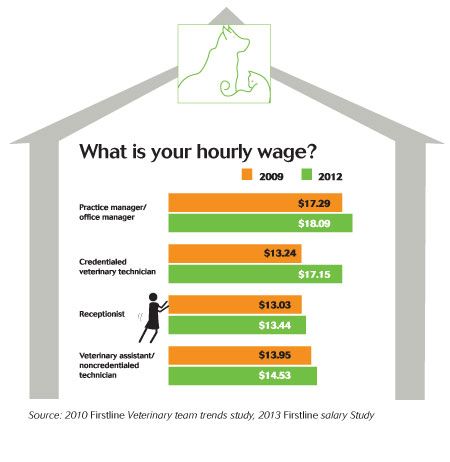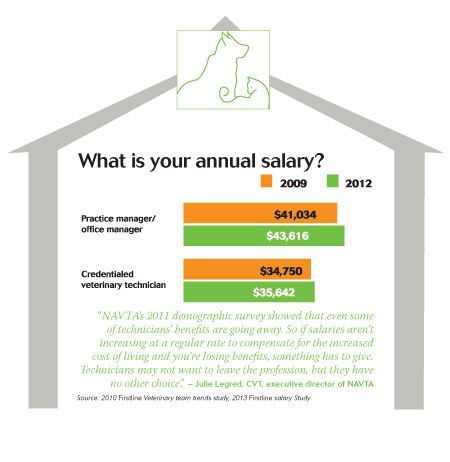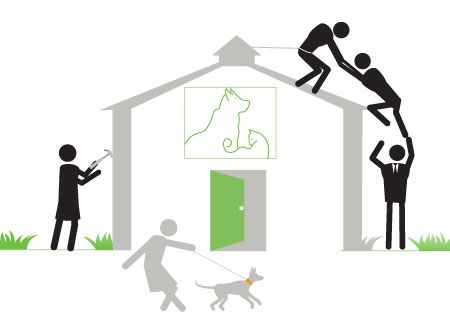An ailing profession: Veterinary team pay
Veterinary team pay has been largely stagnant, with signs of recovery across positions and a growing demand for technicians.
Next >
You want to earn more—and your boss wants to pay you more. But the truth is, they’re feeling pinched by the economy, so they may need your help to build business to the level where they can afford to offer raises. (Read on for salary data.) This first of four dvm360 Leadership Challenges takes a hard look at veterinarians’ ability to afford to pay their team members. First, let’s examine some pertinent facts about the veterinary profession.
On the next pages, you’ll find facts, predictions and data to shed light on the issue of veterinary team pay. Click next to read more.
Source: 2010 Firstline Veterinary Team Trends Study, 2013 Firstline Salary Study

Fact 1: Veterinary practices are making less
The VPI-Veterinary Economics Financial Health Study shows only 22 percent of veterinarians believe the veterinary profession is financially healthy. And only 33 percent of owners say their practices are doing well, while about 16 percent say their practice was less profitable in 2012 and 31 percent report a drop in patient volume.
Fact 2: Technology programs have doubled
“We’ve increased our veterinary technology programs a lot,” says Julie Legred, CVT, executive director of the National Association of Veterinary Technicians in America. “Back when I started as a technician, there were only about 60 programs. Now we’re at 218 accredited programs. And many of these markets aren’t just state schools anymore, they’re for profit.”
All programs need to do a good job of educating the applicants about the profession and what it entails to ensure the applicants have the best chance for success, Legred says.
Fact 3: The demand for technicians is growing
In 2013, Legred worked with the Bureau of Labor Statistics (BLS) to refine their predictions for the demand for technicians. Based on their work, the BLS reported the demand for technicians is expected to increase by 30 percent by 2022, making it a fast-growing position.
What does the future hold?
Without the benefit of a crystal ball, we can still make some educated guesses about where the profession is pointed, especially for team members who are willing to take control of their job outlook and push for change in their practices. Consider these predictions:
1. The need for positions like nurse practitioners and physician’s assistants and specialized technicians will grow, Legred says. For example, there are at least five new veterinary technology specialities being explored in the next few years, from imaging and shelter medicine to alternative medicine, ophthalmology and dermatology.
“When veterinary medicine finally figures out that technicians aren’t going to take the veterinarians’ positions away, a nurse practitioner role will be needed,” Legred says. She also points to the way dentists and eye doctors in human medicine use their team members as a model for how veterinary medicine can grow.
Consider the hourly wages for team members in various positions at the practice below.

2. Technicians who don’t specialize may still find areas they’re more focused on, such as an area of client education.
3. The need for technicians in large animal medicine will increase, as the number of veterinary students interested in large animal medicine declines or the large animal veterinarian role changes to more of a consultant. Technicians have a unique situation in large animal medicine, where they can not only work in a practice-type situation, but as herd managers on large farms and facilities, Legred says.
Consider how annual salaries have changed for team members from 2009 to 2012 below.

4. Team members, especially technicians, who aren’t utilized will continue to leave practices. “Technicians want to use their skills. That’s why they went into this profession,” Legred says. “As doctors realize what technicians can do and feel comfortable with that, team members are going to like their positions more because they’re doing what they’re supposed to be doing.”
Firstline board member Kyle Palmer, CVT, agrees. “Veterinarians must understand that providing the opportunity for team members to utilize their skills does not weaken their control of the practice, it strengthens it.”
And as technicians are properly utilized, the rest of the team can take on more responsibility, and Legred says this builds a happier, more productive team with greater job security and longevity.
“I think we’re going to discover practices can be more productive and generate more profit than they have in the past,” Legred says. “Doctors don’t have to work 18 hours a day to be profitable. They can utilize their team members, and I think everyone will find the outcome is better.”
